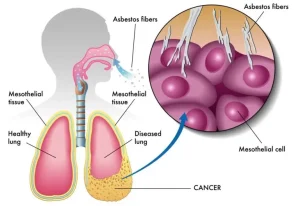Overview
Diagnosis
Diagnosing asbestosis can be challenging because its symptoms are similar to other lung and respiratory conditions.
Physical exam
Your healthcare provider will review your medical history, work history, and potential asbestos exposure. During a physical exam, a stethoscope is used to listen to the lungs for crackling sounds during inhalation, which can indicate lung scarring.
Imaging tests
Imaging helps detect changes in the lungs caused by asbestosis:
-
Chest X-ray. Advanced asbestosis may appear as excessive whiteness or a honeycomb pattern in lung tissue. Both lungs may show signs in severe cases.
-
CT scan (computed tomography). CT scans combine X-ray images from multiple angles to create cross-sectional views of lung tissue. CT scans are more detailed than X-rays and can help detect early-stage asbestosis.
Pulmonary function tests
These tests evaluate how well your lungs work by measuring lung capacity and airflow.
-
Spirometry. You may breathe into a spirometer, which measures the volume of air inhaled and exhaled and the time it takes to fully exhale. Full pulmonary function tests can also measure oxygen transfer to the bloodstream.
Diagnostic procedures
Sometimes, your provider may need tissue or fluid samples to detect asbestos fibers or abnormal cells:
-
Bronchoscopy. A thin tube with a light and camera is inserted through the nose or mouth into the lungs to view airways and collect tissue or fluid if needed.
-
Thoracentesis. A needle is inserted between the ribs into the lung area to remove excess fluid for analysis, often guided by ultrasound.
Treatment
There is currently no cure for asbestosis, and the lung damage cannot be reversed. Treatment focuses on slowing disease progression, relieving symptoms, and preventing complications.
Monitoring
Routine follow-up care, including chest X-rays, CT scans, and lung function tests, is important. Prompt treatment of respiratory infections can help reduce complications.
Therapy
For advanced asbestosis causing breathing difficulties, your provider may recommend:
-
Supplemental oxygen. Delivered via nasal prongs or a mask, it helps improve oxygen levels.
-
Pulmonary rehabilitation. Programs combine breathing exercises, relaxation techniques, and physical activity guidance to enhance overall lung health.
Surgery
In severe cases, a lung transplant may be considered for individuals with advanced asbestosis who meet eligibility criteria.
Advertisement

